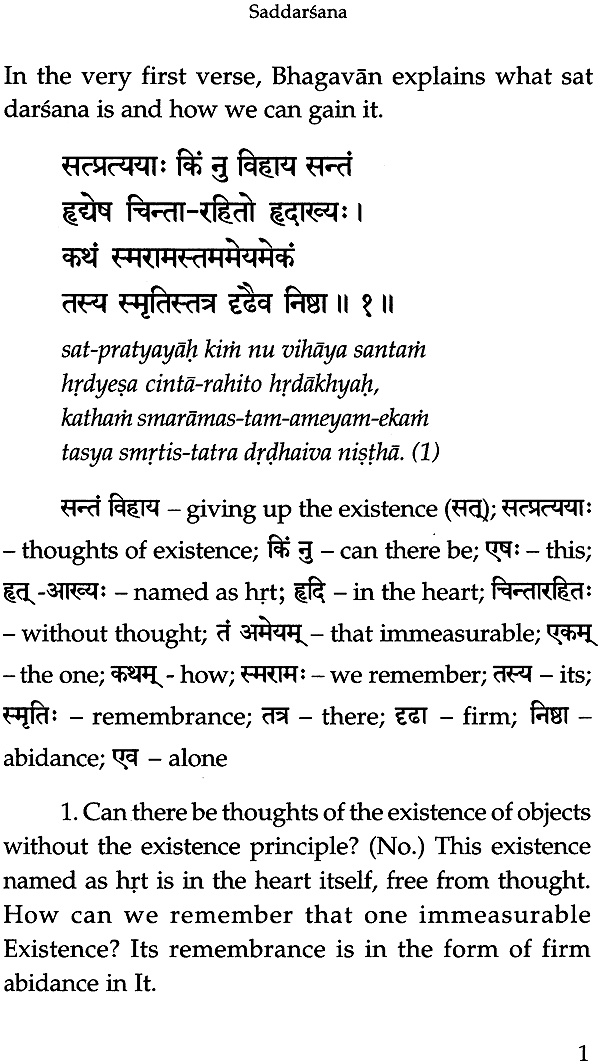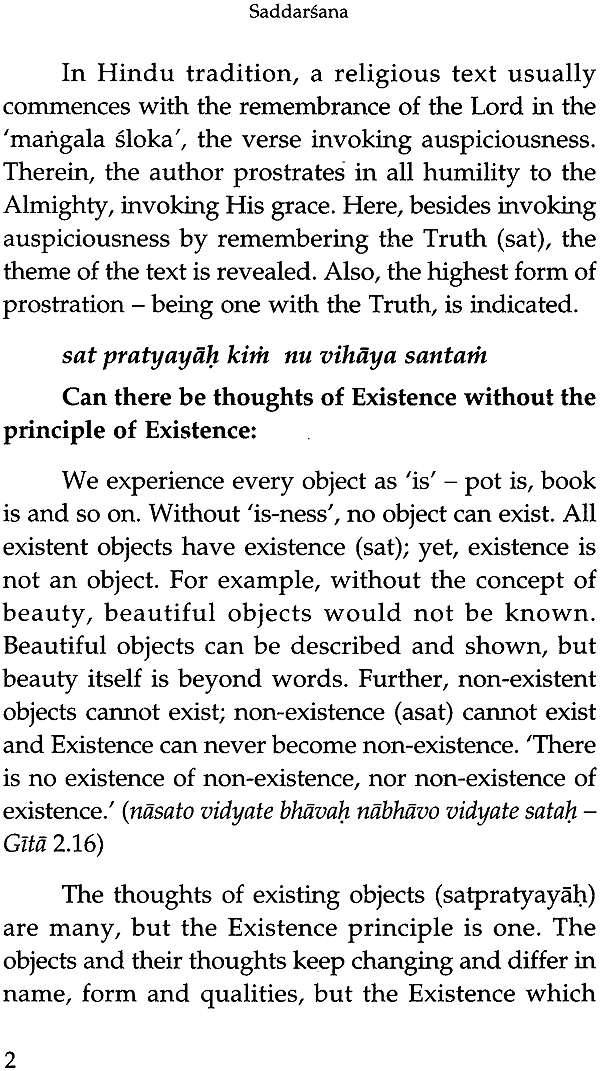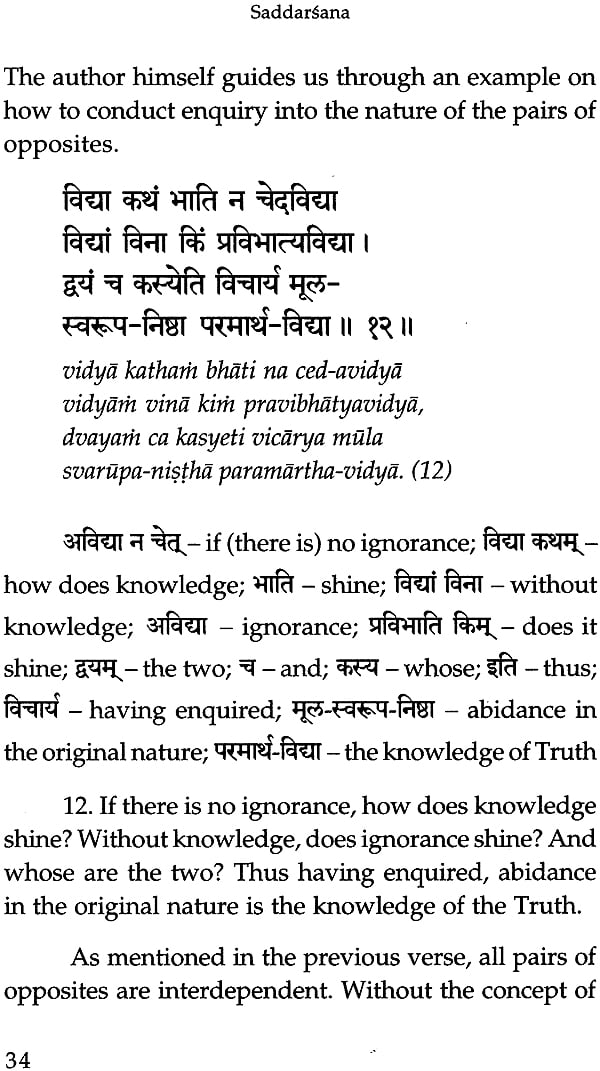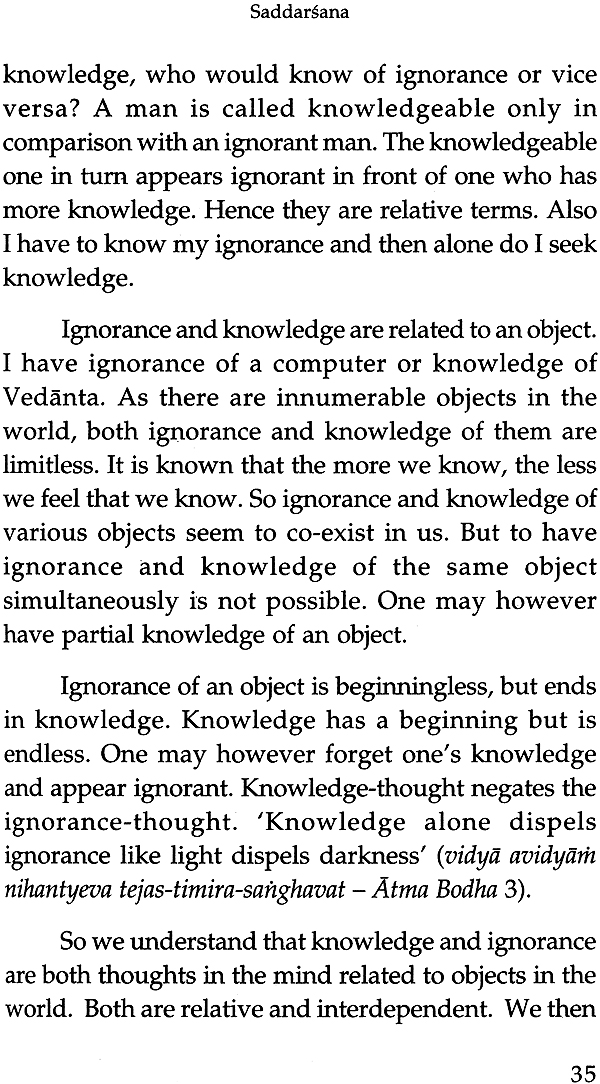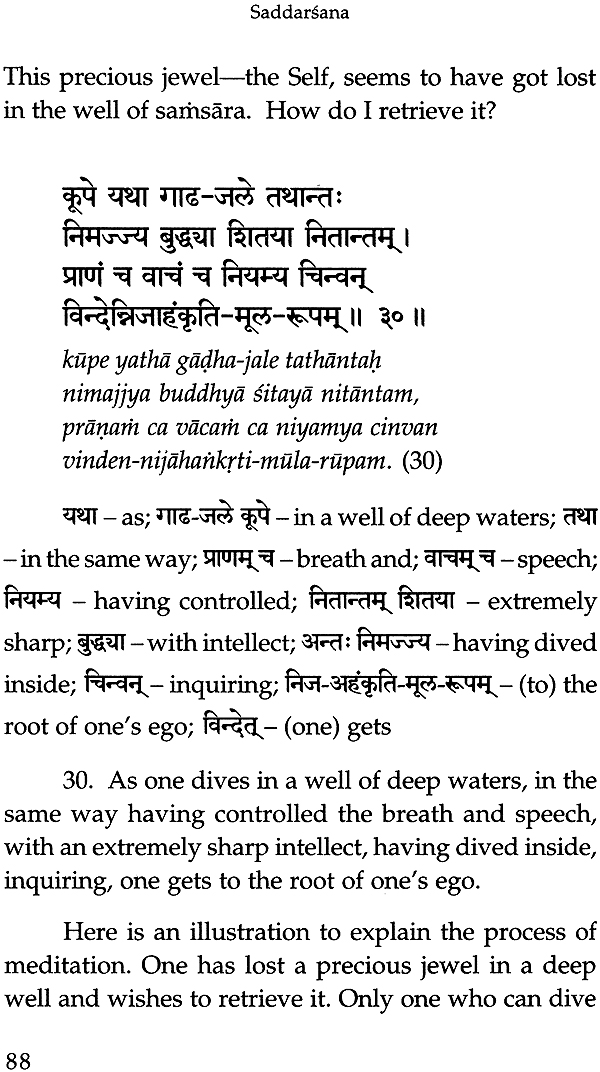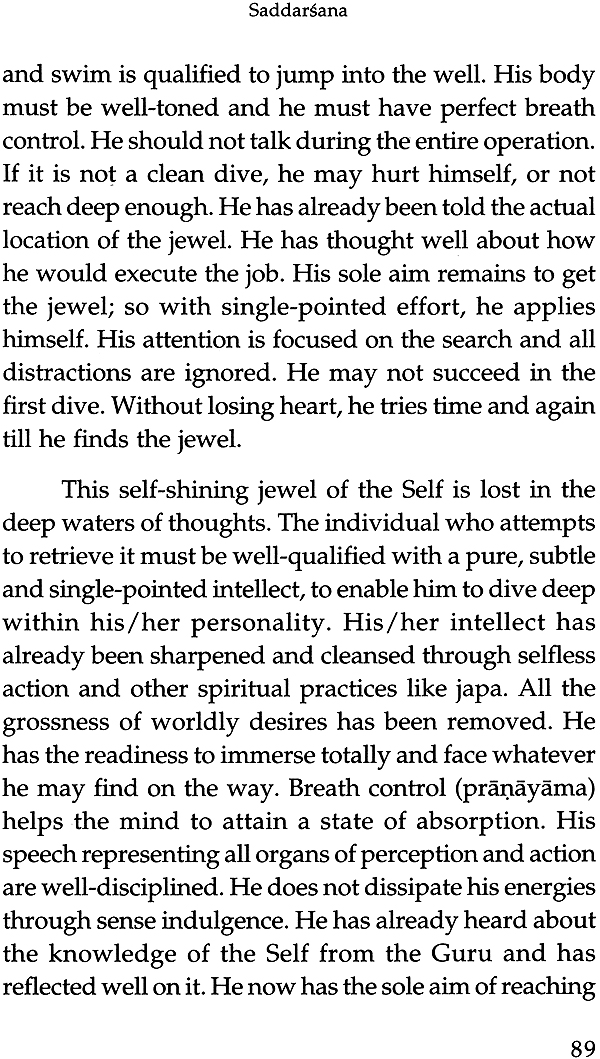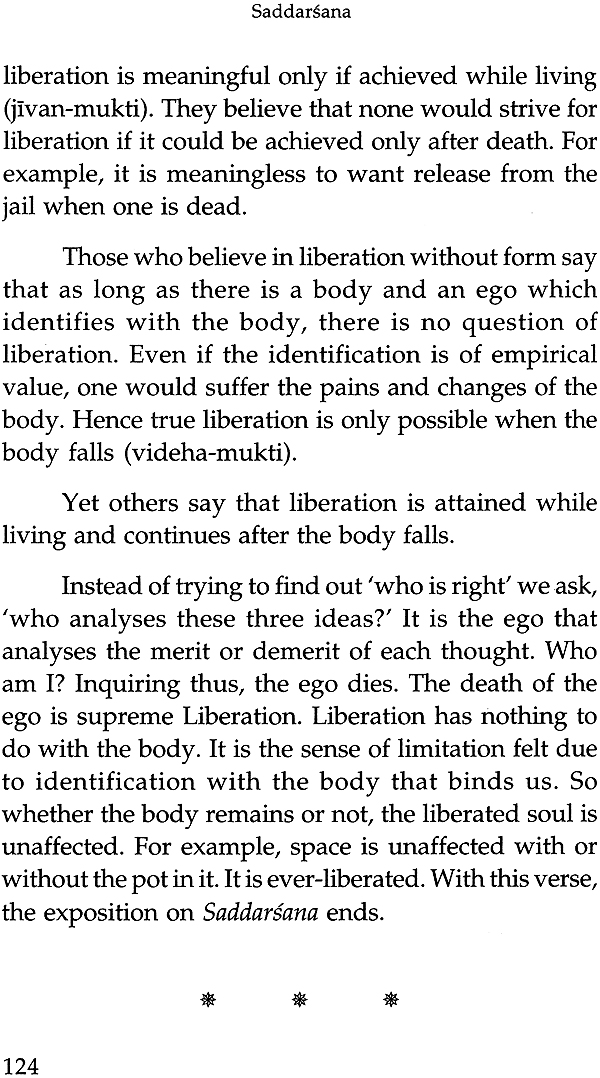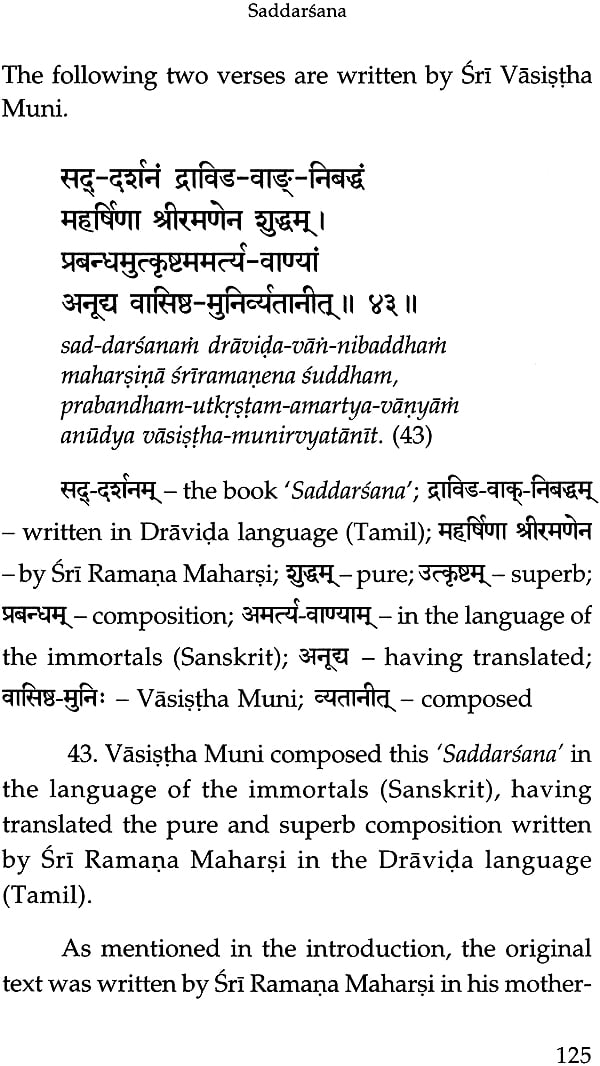
Saddarsana of Bhagavan Sri Ramana Maharsi ((Text, Transliteration, Word-Word-Meaning, Translation and Detailed Commentary))
Book Specification
| Item Code: | IDJ031 |
| Author: | Swami Tejomayananda |
| Publisher: | CENTRAL CHINMAYA MISSION TRUST |
| Language: | (Text, Transliteration, Word-Word-Meaning, Translation and Detailed Commentary) |
| Edition: | 2019 |
| ISBN: | 9788175974456 |
| Pages: | 101 |
| Cover: | Paperback |
| Other Details | 8.4" X 5.4" |
| Weight | 160 gm |
Book Description
Publisher's Note
Bhagavan Ramana Maharshi's approach to the truth has been straight and direct. His line of thinking has attracted all the genuine seekers of truth. What is more remarkable is, he has never by-passed the traditional and scriptural authority while speaking of the truth in his unique way.
Swami Tejomayananda has introduced him to the followers of Chinmaya Mission through his commentary on Upadesa Saaram, a simple, melodious composition revealing the depth of Vedantic philosophy briefly, yet exhaustively.
Swami Tejomayananda's style of exposition on the subtle intricacies of truth hidden in and through the verses of Saddarsanam is vivid, powerful and appealing.
CCMT is honoured to present before seekers of truth yet anther commentary by Swami Tejomayananda on Saddarsanam, a great treatise of vedantic philosophy. The publication is in typical Chinmaya style where the original Sanskrit verse is followed by transliteration with diacritical marks, word-to-word meaning, free translation of the verse and Swamiji's commentary on the import of each word and the total thought.
This text was taught to students of Vedanta Course in Sandeepany Sadhanalaya, Bombay for many batches. However, we did not have a commentary published by our Mission. This long felt need finds fulfillment in the present publication.
In this book, diacritical marks are used for transliteration of sanskrta words in the verses and commentary. Non-English words have been italicized. This will help readers to identify and pronounce the words correctly.
This English plural sign have been added to untranslated sanskrta words after a hypen (-) to show that it is not elemental to the words e.g. Mantra-s, Veda-s, Rsi-s etc.
A key to the transliteration and pronunciation has been added in the beginning of the book.
Bhagavan Ramana Maharsi was born on 30th December, 1879 in Tirucuzhi village in Ramnad district of Tamilnadu. His father Sri Sundaram Iyer was a lawyer by profession. His childhood name was Venkata Ramana. Relations and close acquaintances report that from his early childhood he would go into trances. In reality he was only introspecting. His deep inborn devotion was centred on Arunacala which is worshipped as a Jyotirlinga - the very embodiment of Lord Siva.
Ramana Maharsi's father died when he was very young. Young Ramana did not know then, where Arunacala was located, but he knew well that it was his final destination. In 1895, a relative from Madurai informed him that Arunacala was in Tiruvannamalai in Tamilnadu.
A year later on 29th August 1896, Venkata Ramana took three rupees from his elder brother's fees and left home for Tiruvannamalai. Before leaving home he left a note, asking his family not to waste money in his search. The money for the rail fare was insufficient so he pawned his earrings. On reaching Tiruvannamalai, he threw the remaining money into the lake opposite the temple. Having thus renounced all worldly ties, he said words to this effect, “At Your command, I have come to You." Thus saying, he surrendered totally at the altar of Arunacala. From then on, he never left Tiruvannamalai. He attained Mahanirvana on 14th April 1950, at the age of seventy one.
For the first five months of his stay at Tiruvannamalai, he lived within the temple premises located at the foothills of Arunacala Mountain. He would go into long periods of Self-absorption (samadhi). Later, he shifted to the place of bhu-samadhi (place of burial place of noble souls) of a Mahatma (noble soul) and still later to a mango orchard. He lived in silence and solitude for years in two different caves of Arunacala and the final years, near the place of bhu-samadhi of his mother. Bhagavan's mother was living with him from 1916 and had died in 1922.
Sri Ramana Maharsi spent his early days at Tiruvannamalai in detachment, silence and self- enquiry. He was known as a man of severe penance, a saint and a divine soul. Some believed him to be an incarnation. His fame spread far and wide and people from all parts of India and other foreign lands came to him and became his ardent devotees.
Sri Ramana Maharsi has composed a few poems in Tamil. They show his literary skill, talent and deep devotion and reflect his vivid insight. His teaching is available in many other books like Ramana Gita, Talks with Ramana Maharsi, Saddarsana, Day by day with Bhagavan and the News-letters of Ramanasram. He had a good command over many languages and had translated his own Tamil compositions into Sanskrit, Malayalam and Telugu.
He was the very embodiment of divine virtues and his life manifested those fully. To this day, he inspires lakhs of people, irrespective of class, colour, gender and nationality.
In India, philosophy is called 'darsana sastra' _ the science of 'seeing' life. Bhagavan Ramana Maharsi, in the present text Saddarsana, explains what is true vision or the vision of Truth.
We all perceive the world and take our perceptions to be real. But are they so? Is what we understand of life and the world, the complete Truth? Such fundamental questions may seem redundant or even scary to the unthinking mind. Even modern science proves conclusively that our experience of the world is relative, incomplete or at times totally unreal.
My perceived world is the sum total of experiences gathered through my senses - ears, skin, eyes, tongue and nose as sound, feel, form and colour, taste and smell. Does the world appear the same to all? Surely, the world to an ant and an elephant, a unicellular amoeba and a man, a child and an adult, appear different. A blind man is dead to one-fifth of my experiences. He lives in a world without forms and colours and a deaf man without sounds. Moreover, if I add an external instrument to my sense organs, the world would be different even to me. My hand which seems otherwise clean has innumerable bacteria, viruses and dust particles when seen under a microscope. Furthermore, the likes and dislikes of my mind colour my vision of the world. I become blind to the faults of the one I love and see only bad in the one I dislike. My intellect too adds to my unique experience of the world by its own way of judging and analyzing. Add to that the cultural differences, peer and group pressure, newspaper and TV influences and we realize that each of us perceives and understands this world in our own subjective way. From a particular standpoint the world appears one way, but as the standpoint. changes, appearances also change. So what we perceive is not absolutely 'real' or 'as it is' but appears in a particular way due to the limitations, defects, qualities and nature of the instruments through which we experience it. What we see is not the Truth, but a version of it. It is a relative reality and not the Absolute Reality.
Knowledge of objects and phenomena of the world (jagat) is not the total understanding of life. Without knowing the knower, the individual (jiva), such knowledge is incomplete. Moreover, we know that we have neither created the world nor ourselves. Hence there must be a Creator (lsvara) of this world of things and beings. Only with the understanding of jiva, jagat and Isvara, their inter-relation and true nature, can we know the complete Truth. We realize that at present ours is a very limited view of life.
A misunderstanding may arise from the above statement that there are two realities, the relative and the absolute. The relative is what we experience and the absolute. is something out of this world or apart from our experience. That is not so. It is our experience of that one Truth, that is relative and this relative know ledge differs from person to person. Our experience is conditioned by the instruments we use . If we have to know the Truth' as it is', we would have to remove the instruments. Whatever would then remain would be the Truth in its pure form. This 'seeing' without eyes and 'knowing' without thoughts is 'sat darsana'. Hence, seeing the Truth is being the Truth. It is not seeing an object apart from the Seer. For instance, presently I see myself as a human being by being one and behaving like one. Imagine then the state of one who remains in this world as absolute Reality itself.
One may well ask, what is the purpose of knowing the Truth? What do we stand to gain? We are quite comfortable living in this plane of relative reality with our own pet pleasures and pains. Let us examine this.
All beings, without exception, work to be happy and want to get rid of sorrows through possessing and enjoying material things and pleasures. But by this way, sorrow is not seen to end. Inquiring into the root of our sorrow, we realize that it is the false vision of life due to which we suffer. If a person, mistakenly, takes himself to be his reflection in a mirror, then would he not be pained to see his bloated form in a convex mirror? If he realizes that he is free from the limitations of both the mirror and the reflections therein, he begins to enjoy the spectacle in front of him. Thus knowing the Truth, he is totally freed from superimposed sorrows and limitations and enjoys unconditioned bliss, 'total cessation of sorrow and attainment of supreme happiness' (atyantika duhkha nivrttih paramananda praptih. ca).
Let us enquire - who is a fit student for this knowledge? It is one who wishes to wake up from this illusion which one has been believing to be real from innumerable lifetimes. An inquiring mind alone would hit on the possibility that what is experienced may be unreal and would want to know the real.
The question then is - am I a fit student? The following acid test would show our fitness:
(a) If required to do so, am I willing to do what I do not like and give up what I like?
(b) If I am told that the Truth would disturb or end my present way of life, am I still willing to give it up and know the Truth?
(c) If I am faced with the fact that the Truth is somehow terrible and bitter, am I willing to know it?
(d) Am I willing to pursue it, whatever the cost? I may even have to face death like Naciketas.
If I answer yes to all of the above, I stand a good chance. On the other hand if I say:
(a) What is the material benefit of knowing the Truth?
(b) What is the use of this knowledge in continuing my worldly life comfortably?
(c) I am willing to accept only what appeals to my mind and inclinations.
(d) I am unwilling to sacrifice anything.
Then, I am unfit for this knowledge, because I am more interested in the comforts of my present life than in knowing the Truth.
With this understanding of sat darsana. its purpose and our fitness, we shall start the study of this text. It was originally written by Bhagavan Ramana Maharsi in Tamil. It was translated into Sanskrit by his devotee, Vasistha Ganapati Muni.
This is not a text to refute or to establish a particular school of thought. It does not take up the analysis of duties, morals and code of conduct for man.
It is not a book of categories (prakarana grantha) like Vivekacudamani. Here, the Maharsi revels in his experience of Truth and talks of the inquiries that led to it.
